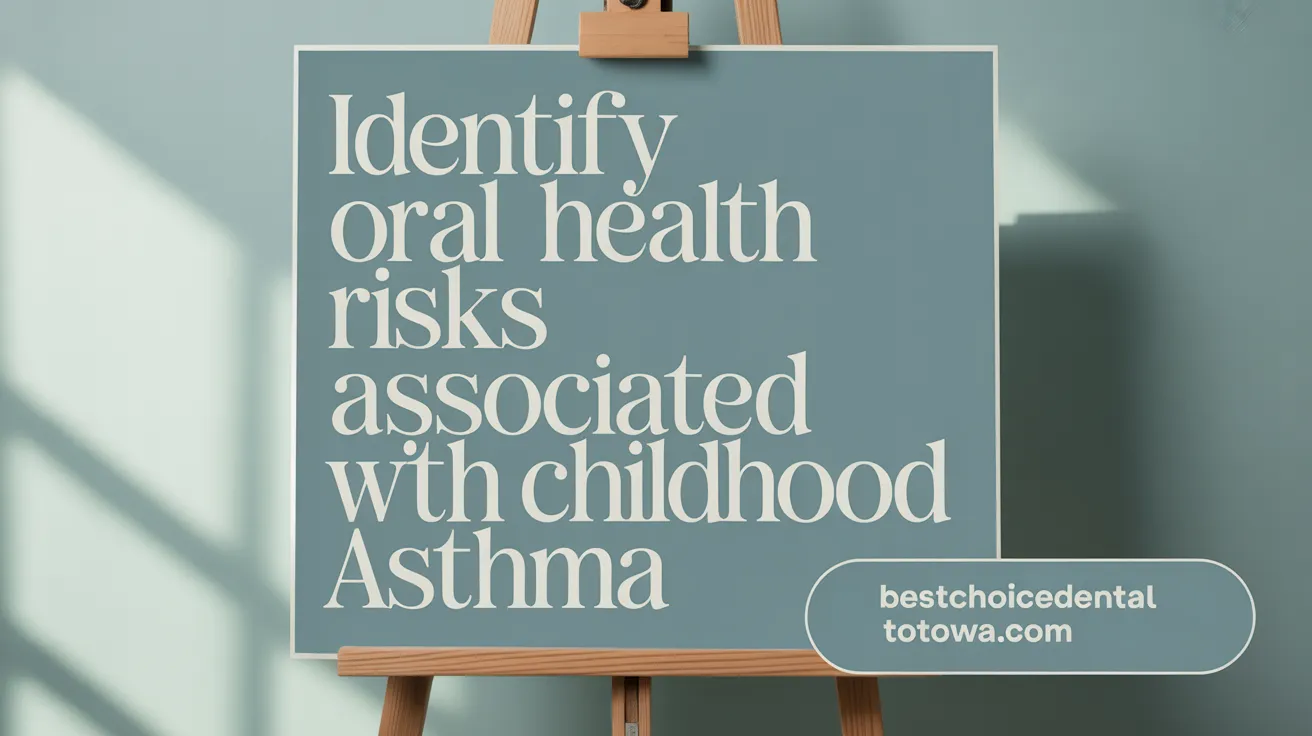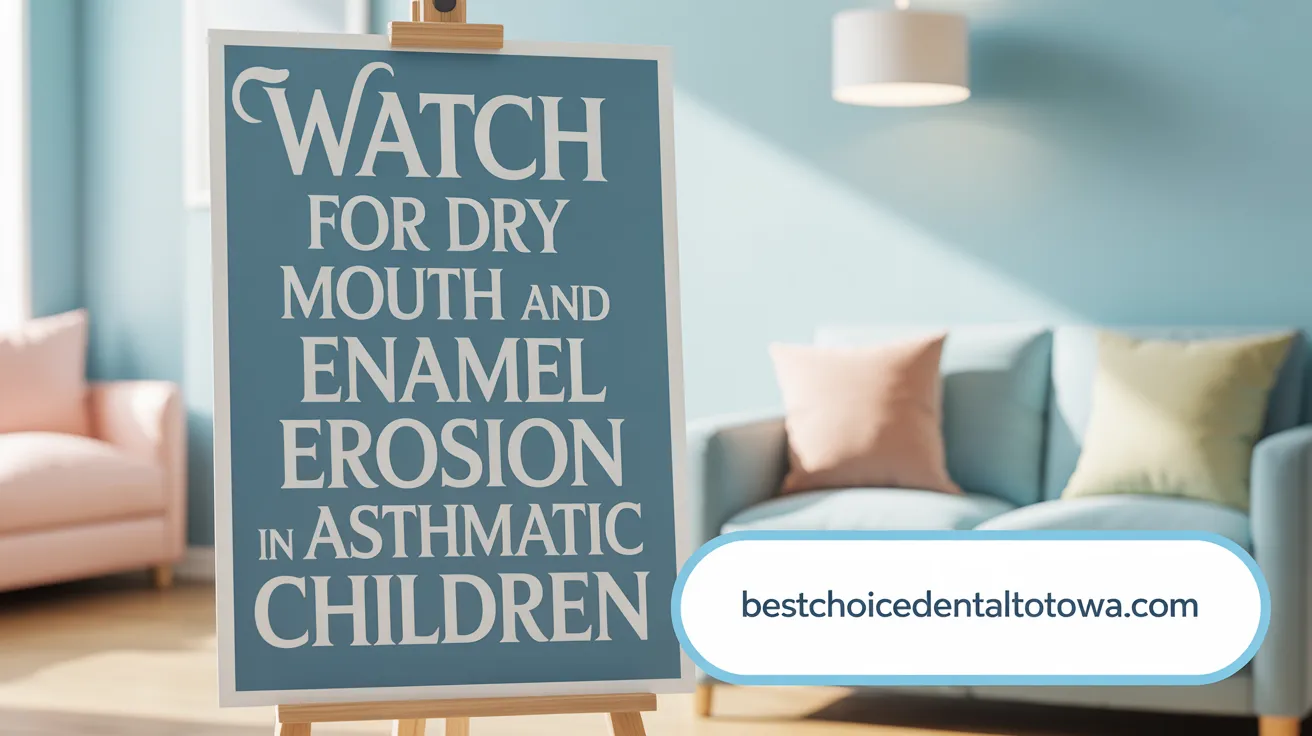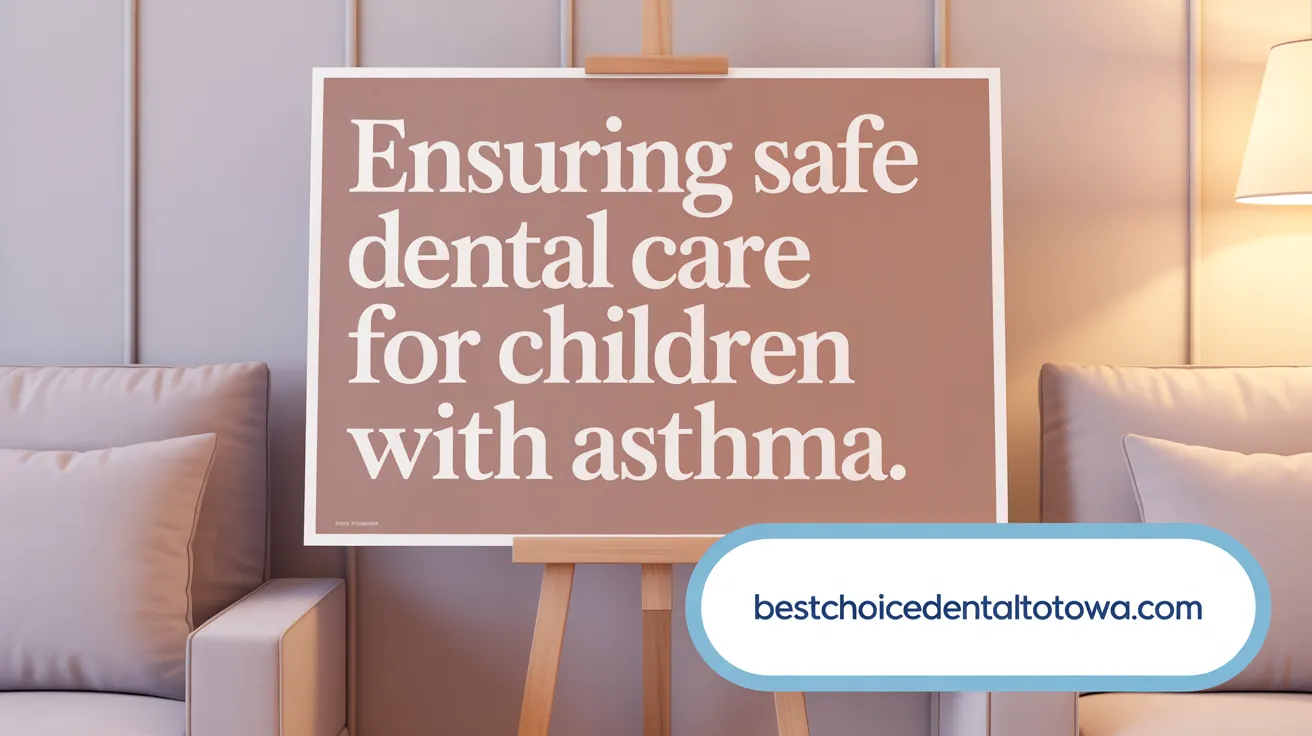Understanding the Oral Health Challenges Faced by Children with Asthma
Childhood asthma affects millions globally, bringing respiratory challenges that extend beyond the lungs. Recent research highlights that children with asthma are at a heightened risk for various oral health problems, including dental caries, gum disease, enamel defects, and oral infections. This article explores the unique oral health risks connected to asthma and its treatments, offering guidance on specialized dental care approaches to maintain and protect the smiles of children living with this chronic condition.
How Asthma Affects Oral Health in Children

What oral health issues are children with asthma at increased risk for?
Children with asthma are more prone to several oral health problems. These include dental caries and enamel defects due to reduced saliva protection and acidic environments in the mouth. They also often experience gingivitis and periodontal disease because of changes in oral microbial balance and inflammation. Additionally, malocclusions like overjet, overbite, posterior crossbite, and a high palatal vault have been observed, possibly linked to mouth breathing and respiratory challenges. Oral candidiasis and dry mouth are common, caused by both the condition and its treatments, further increasing vulnerability to oral infections. For more details, see Oral health in children with asthma.
How do asthma medications impact oral health?
Medications for asthma, particularly bronchodilators and inhaled corticosteroids, significantly affect oral health by decreasing salivary flow and altering the saliva's protective components. This xerostomia, or dry mouth, reduces the mouth's natural cleansing and buffering capacities, elevating the risk for dental caries and fungal infections like oral candidiasis. Moreover, many inhalers have low pH, which promotes enamel erosion. These drugs can also reduce salivary immunoglobulins and enzymes that protect against pathogens, exacerbating oral disease risks. Refer to oral health in asthmatic patients and Asthma and Oral Health for comprehensive information.
Gingivitis and periodontal disease prevalence in asthmatic children
Due to inflammation from asthma and reduced salivary defense, children with asthma demonstrate a higher prevalence of gingival inflammation and periodontal disease. Mouth breathing and medication side effects contribute to plaque accumulation and gum irritation, requiring vigilant oral hygiene and regular dental care. Detailed insights can be found in Periodontal disease in asthmatic patients and Dental health in children with asthma.
Malocclusion and dental morphology changes associated with asthma
Asthmatic children often show changes in facial and dental development, such as increased facial height, high-arched palates, and a greater incidence of posterior crossbites. These changes may relate to chronic mouth breathing and impaired nasorespiratory function, influencing occlusion patterns. For more information, see Facial and dental features associated with asthma in children and Asthma and Oral Health Risks in Children.
Oral candidiasis and dry mouth linked to asthma and medication
Inhaled corticosteroids can suppress local immunity, resulting in a higher incidence of oral candidiasis, a fungal infection presenting as white patches inside the mouth. Dry mouth from medication use further exacerbates this risk, making preventive rinsing and proper oral hygiene crucial. See Oral candidiasis in asthmatic patients and Dental care for children with asthma for practical guidance.
Effects on saliva flow and composition
Asthma medications reduce saliva quantity and affect its biochemical composition, including decreased amylase, peroxidase, lysozyme, and immunoglobulin A. Lower saliva flow and altered protective enzymes weaken the mouth's defense against cariogenic bacteria and fungi, fueling oral disease prevalence among children with asthma. For comprehensive coverage, review Asthma medications and saliva flow and Oral immune defense impairment in asthma.
Medication Side Effects and Their Oral Health Implications

What are the oral side effects of asthma medications?
Asthma treatments, particularly inhaled corticosteroids, can lead to oral candidiasis by suppressing the immune response in the mouth. Bronchodilators and beta-2 agonists reduce salivary flow, causing dry mouth, which diminishes saliva's natural protective effects and raises the risk of cavities. Additionally, many inhalers contain sugars or have acidic components that dissolve tooth enamel, accelerating dental decay.
Gastroesophageal reflux disease (GERD), more common in children with asthma, exposes teeth to stomach acids, increasing dental erosion. This combination of factors—from reduced saliva to acidic environments—creates a vulnerable oral surface prone to caries and enamel wear. For more detailed information, see oral health in asthmatic patients, Asthma medications and oral side effects, and Asthma and dental caries study.
How can the negative oral effects of asthma medications be minimized?
Preventive oral care is crucial to managing these risks. Rinsing the mouth thoroughly with water immediately after using an inhaler helps wash away residual medications that could harm teeth and oral tissues. Using spacer devices with inhalers reduces the amount of medication deposited directly in the mouth, lowering side effects like candidiasis and enamel erosion.
Maintaining good oral hygiene with regular brushing using fluoride toothpaste, flossing, and frequent dental visits supports oral health. In cases of oral thrush, topical antimycotic treatments may be prescribed by dental professionals. Hydration through drinking water further mitigates dry mouth symptoms, protecting against bacterial growth and acid damage.
For practical recommendations and detailed guides on managing oral health with asthma, consult Managing Oral Health with Asthma, Dental care for children with asthma, and Special dental care for asthmatic children.
By combining medication management with diligent oral care practices, children with asthma can reduce the dental side effects associated with their treatment and maintain healthier smiles.
Dental Management Strategies for Children with Asthma

Assessment of asthma control before dental procedures
Before any dental treatment, it's essential to evaluate the child's current asthma control level. This includes reviewing recent symptoms, frequency of attacks, and medication adherence. Treatments should be postponed if asthma is poorly controlled to reduce risk of an exacerbation during dental care. For detailed guidelines, see Dental management of children with asthma.
Premedication with bronchodilators
Administering a bronchodilator prior to dental procedures can help prevent bronchospasm and ease breathing. This proactive step is especially useful in children with moderate asthma or when procedures might provoke respiratory irritation. Refer to Premedication protocols for asthmatic children for more information.
Emergency preparedness including availability of inhalers, oxygen, epinephrine
Dental settings must be equipped with the child’s inhaler, supplemental oxygen, and epinephrine for rapid response to asthma attacks or allergic reactions. Staff should be trained to promptly recognize distress signs and execute emergency protocols, including calling emergency medical services if required. See Emergency management of asthma attacks in children for emergency procedures.
Use and contraindications of nitrous oxide sedation
Nitrous oxide sedation may be safely used in children with mild to moderate asthma to alleviate anxiety and facilitate treatment. However, it is contraindicated during active wheezing episodes or severe asthma exacerbations. Consultation with the child’s physician is advised before administration. For detailed considerations, consult Use of nitrous oxide in asthmatic pediatric patients.
Avoidance of dental materials triggering asthma symptoms
Certain dental materials such as some fluoride trays, fissure sealants, cotton rolls, or dentifrices can exacerbate asthma symptoms in sensitive children. These should be avoided when possible or used with caution, and all materials should be reviewed for potential irritants. See Dental materials affecting asthma symptoms for guidance.
Latex allergy precautions during dental care
Children with severe latex allergy require strict avoidance of latex-containing items including gloves and rubber dams, as exposure can provoke serious allergic reactions. Non-latex alternatives should be used consistently. Refer to Precautions for latex-allergic children in dentistry.
Behavior and stress management to avoid asthma triggers
Managing anxiety and stress in the dental office is crucial since fear or distress can trigger asthma attacks. Techniques such as creating a calm environment, explaining procedures clearly, and using mild sedation (where safe) can improve cooperation and reduce risks. Learn more from Managing asthma during dental procedures.
What precautions should dental professionals take when treating children with asthma?
Dental teams must assess asthma control, ensure the child took medications timely, prepare emergency medications (bronchodilators, epinephrine), avoid known triggers including aspirin and certain dental materials, and cautiously approach sedation with nitrous oxide, avoiding it during wheezing. Additional details available at Asthma and oral health risks in children.
How should emergency asthma attacks be managed in dental settings?
Immediate steps include halting dental treatment, seating the child upright, administering inhaled bronchodilators, supplying oxygen, and if symptoms escalate, giving epinephrine and calling emergency medical services. For emergency protocols, refer to Emergency management of asthma attacks in children.
These management strategies allow safe, effective dental treatment tailored for children with asthma, minimizing risks and ensuring prompt responses to emergencies. For comprehensive dental care recommendations, see Dental care for children with asthma and Oral health in asthmatic patients.
Preventive Oral Health Measures and Patient Preparation
What preventive oral health measures benefit children with asthma?
Children with asthma face greater risks of dental cavities and gum disease due to medication side effects like dry mouth and enamel erosion. To protect their oral health, several preventive steps are crucial.
Regular dental visits starting by age 1 allow early detection and management of oral problems. Most children should visit every 6 months, though higher-risk kids may need more frequent checkups (Dental care for children with asthma, Dental health in children with asthma, Oral health for children with breathing conditions).
Daily habits include brushing twice with fluoride toothpaste and flossing to remove plaque buildup. Drinking fluoridated water strengthens enamel and moderates acid attacks from inhalers (Asthma medications and dental health, Managing Oral Health with Asthma).
Limiting sugary and acidic foods and drinks reduces cavity-causing bacteria growth. Using fluoride varnishes or supplements, prescribed by dentists, further fortifies teeth against decay (Risk factors for caries in children with asthma, Dental care for children with asthma).
Spacer devices attached to inhalers can lower medication residue in the mouth, helping to decrease oral side effects such as thrush and erosion (oral health in asthmatic patients, Dental care tips for children with asthma, effects of inhaled corticosteroids on saliva).
How should parents prepare their asthmatic child for dental visits?
Preparation helps minimize the risk of asthma attacks and dental complications. Parents should ensure the child takes all asthma medications on schedule prior to the appointment (Asthma prevalence in children, Dental management of children with asthma).
The child should be well-rested and free from recent respiratory symptoms. Bringing the child's inhaler to every dental visit is essential (Dental care for children with asthma, Children with asthma and dental risks).
Parents must inform the dental team about asthma severity, medication use, allergy history, recent attacks, and any triggers. This information allows healthcare providers to tailor treatment and emergency readiness (Dental care for children with asthma, Asthma and oral health risks in children, management of GERD-related dental erosion in asthma patients.
Good communication among parents, dentists, and pediatricians or pulmonologists ensures coordinated care, including assessment of extra protective measures during dental procedures (Coordination between pediatrician and dentist, Dental considerations for asthmatic children.
By combining effective oral hygiene, dietary caution, and careful preparation, children with asthma can maintain healthier teeth and gums while safely receiving dental care.
Unique Oral Health Challenges and Future Directions
How does asthma severity affect oral health outcomes?
Children with severe asthma often experience notably poorer oral health compared to their peers. This includes increased dental caries, higher plaque index scores, and worsened periodontal conditions. Studies indicate a positive correlation between the severity of asthma and the level of oral disease, with longer durations of inhalation medication use exacerbating these risks. For instance, prolonged use of corticosteroids and bronchodilators may decrease salivary flow and protective components like salivary IgA, leading to increased susceptibility to cavities, gingivitis, and oral candidiasis (source, effects of inhaled corticosteroids on saliva, oral health in asthmatic patients).
What unique dental issues do children with asthma face, and how can care be optimized?
Asthmatic children may exhibit distinctive dental and facial morphology alterations, such as increased facial height, a higher palatal vault, and a greater prevalence of malocclusions like posterior crossbites. These changes are often related to chronic mouth breathing and impaired nasorespiratory function. Additionally, gastroesophageal reflux disease (GERD), commonly seen in asthmatics, contributes to dental erosion due to acid exposure (oral health in asthmatic patients, impact of bronchial asthma on oral health).
Optimizing care requires individualized preventive dental programs that include frequent oral health monitoring tailored to the child's risk profile. Preventive strategies encompass rigorous oral hygiene practices, use of fluoride treatments, spacer devices with inhalers, and managing GERD symptoms. Moreover, coordinated care among pediatricians, pulmonologists, and dentists is vital. This team-based approach ensures comprehensive management of both systemic asthma control and oral health, enabling timely interventions and minimizing dental complications (dental management of children with asthma, dental care for children with asthma, oral health in asthmatic patients.
Ensuring Healthy Smiles for Children with Asthma
Asthma presents distinctive oral health challenges that necessitate specialized dental care for affected children. Understanding the interplay of asthma, its medications, and oral health is crucial for preventing complications such as cavities, gum disease, and oral infections. Through proactive preventive measures, careful dental management, and close collaboration between parents, dentists, and healthcare providers, children with asthma can maintain robust oral health. Early intervention, tailored treatment plans, and emergency preparedness are vital to safeguarding the smiles and overall well-being of these young patients.
